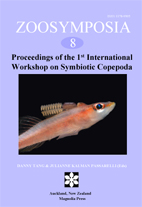Abstract
This report provides the first description of the male of Prosaetes rhinodontis (Wright, 1876) (Copepoda, Siphonostomatoida, Cecropidae) based on specimens collected from two whale sharks (Rhincodon typus Smith) held in sea pens off the west coast of Okinawa-jima Island, Japan. We argue that the morphology of P. rhinodontis contributes significantly to the blurring of familial limits between Cecropidae Dana, 1849 and Pandaridae Milne Edwards, 1840 and based on our detailed consideration of this matter we recommend that Cecropidae be recognized as a junior synonym of Pandaridae. Accordingly, we transfer P. rhinodontis, along with species of Cecrops Leach, 1816, Luetkenia Claus, 1864, Philorthagoriscus Horst, 1897, Orthagoriscicola Poche, 1902, and Entepherus Bere, 1936, to the Pandaridae. In addition, our critical evaluation of the morphological features of the adult female and copepodid I of Amaterasia amanoiwatoi Izawa, 2008 indicated that the establishment of Amaterasidae Izawa, 2008 to hold the species was unfounded because A. amanoiwatoi can be accommodated within Pandaridae. Thus, we transfer A. amanoitwatoi to Pandaridae and consider Amaterasidae to be a junior synonym of Pandaridae. Lastly, our comparisons of morphological and ecological attributes of A. amanoiwatoi, specimens of “Nesippus costatus? Wilson, 1924” (Pandaridae) reported by Lewis in 1964, and other pandarids (Pandaridae) revealed the first two taxa to be strikingly similar and suggested them to be congeners. Based on those results we propose Lewis’ specimens represent a new species, which we name Amaterasia lewisi n. sp. Within the Pandaridae, Amaterasia spp. seem to belong to the Dinemoura-group based primarily on their similarity to some Nesippus spp., while representatives of Prosaetes, Cecrops, Luetkenia, Philorthagoriscus, Orthagoriscicola, and Entepherus are more confidently considered members of the Dinemoura-group based on their shared possession of a narrow third pedigerous somite and dorsal plates on the fourth pedigerous somite in the adult female and a modified leg 3 terminal endopodal segment in the adult male.

